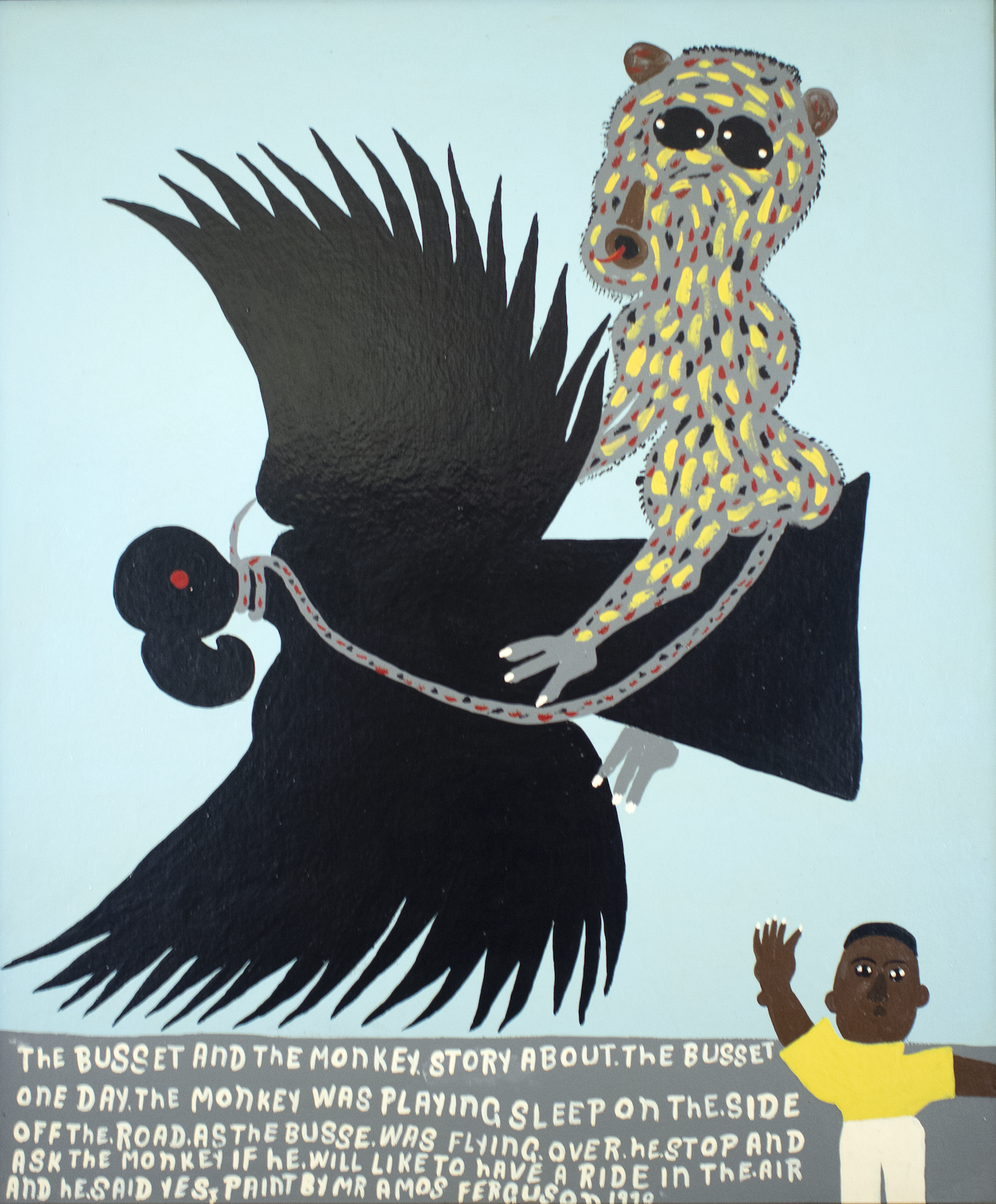
By Natalie Willis
What do the following have in common: Phil Stubbs, Nat King Cole, a buzzard, a monkey, and a plot twist?
“The hungry buzzard said to the monkey
“Let’s go for a ride”
Once in the air he said “monkey, you’re about to die”
The monkey curled his tail around the buzzard’s neck
There was a cry, “Your grip is too tight”
The monkey said, “Then straighten up and fly right””
– Verse from “Stress” by Bahamian musician Phil Stubbs
The musical stylings of Bahamian favourite Phil Stubbs, no doubt inspired by the Nat King Cole classic, in this story of the monkey and the buzzard, speak to fable, myth and reality. Amos Ferguson was also quite clearly inspired by this story, as we see in his painting “The Bussett and the Monkey” (1991), currently on display in central Andros as part of the NAGB’s Inter-Island Traveling Exhibition “TRANS: A Migration of Identity”.
We are a people of rather strong oral tradition, though of course we see much of said tradition being lost these days, though a few key individuals are making efforts to transcribe our stories for future generations. But this isn’t something particular to us as Bahamians, or even just as Caribbeans. It is something that the wider Black diaspora share as part of our shared culture and shared histories. For us, it stems back to Africa and along the way the stories pick up certain colourful additions, drop others, and the result is a weaving of personalized, localized experiences and lessons we can all share and appreciate.
Truly, language in all its forms is at the forefront of this – in storytelling, in dialect, in narratives and narrators and in how we frame it all. Amos Ferguson has always been known for his lively titling of work, and this one is a piece of literary brilliance compared to his usual. Most of his titles are but a few words long, but the title for “The Bussett and the Monkey” is truly a piece de resistance. The full title is as follows:
“The Bussett And The Monkey. Story About The Bussett
One Day. The Monkey Was Playing Sleep On The. Side Of Road.
As The Bussett Was Flying Over. He. Stop And Ask The Monkey
If He Will Like To Have A Ride In The Air And He. Said Yes.”
Ferguson’s illustration, in his usual house paint on cardboard in his skillful flattened planes of colour, shows a black bird being strangled by a rather colorful monkey, with a masculine figure in the bottom right corner watching the whole bizarre set of events take place. The trickster buzzard, according to the tale, takes advantage of a number of animals before encountering the monkey. The bird takes other animals quite literally for a ride, only to drop them, sending them crashing to the ground – a perfect meal for a carrion bird.
How does Nat King Cole tie into it all? Well, the famously silken-voiced star had his first ever published and produced song, and his first hit with “Straighten Up and Fly Right”, a song he wrote in 1943 alongside Irving Mills. The song saw them sitting comfortable near the top of the pop charts for weeks. The lyrics to “Straighten Up and Fly Right” give a fuller version of the story than Phil Stubbs’ short verse in “Stress”, and the inspiration for the song stems from Cole listening to his preacher father’s sermon telling of the story – no doubt as a warning against deceiving others. Cole’s father had clearly heard the Black folktale years before, though it’s difficult to find its exact origins.
The story is part of a longer history that becomes very nebulous to discern, but Ferguson’s key inclusion of a bystander in the bottom right corner is something quite new. Is this the narrator of the story? Given recent political events around land use and neocolonial stings of promised “development” and jobs, we can begin to wonder who is the monkey and who is the “bussett” in this story, and are we as Bahamians merely bystanders here? Are we the buzzard being choked out in the sky, thinking himself to be quite the clever birdie only to fall victim to our own plans?
Perhaps Ferguson himself is toying with us, but it’s certainly up to us to discern what lesson we wish to learn from this story of predatory birds preying on smaller creatures, and the power we have if we learn to utilise what we’ve been given.
“TRANS: A Migration of Identity”, curated by Richardo Barrett and Abby Smith, will be on view at Brigadiers Restaurant and Villas in Davis Creek, Andros until the 29th of November and is free to view by the public.
